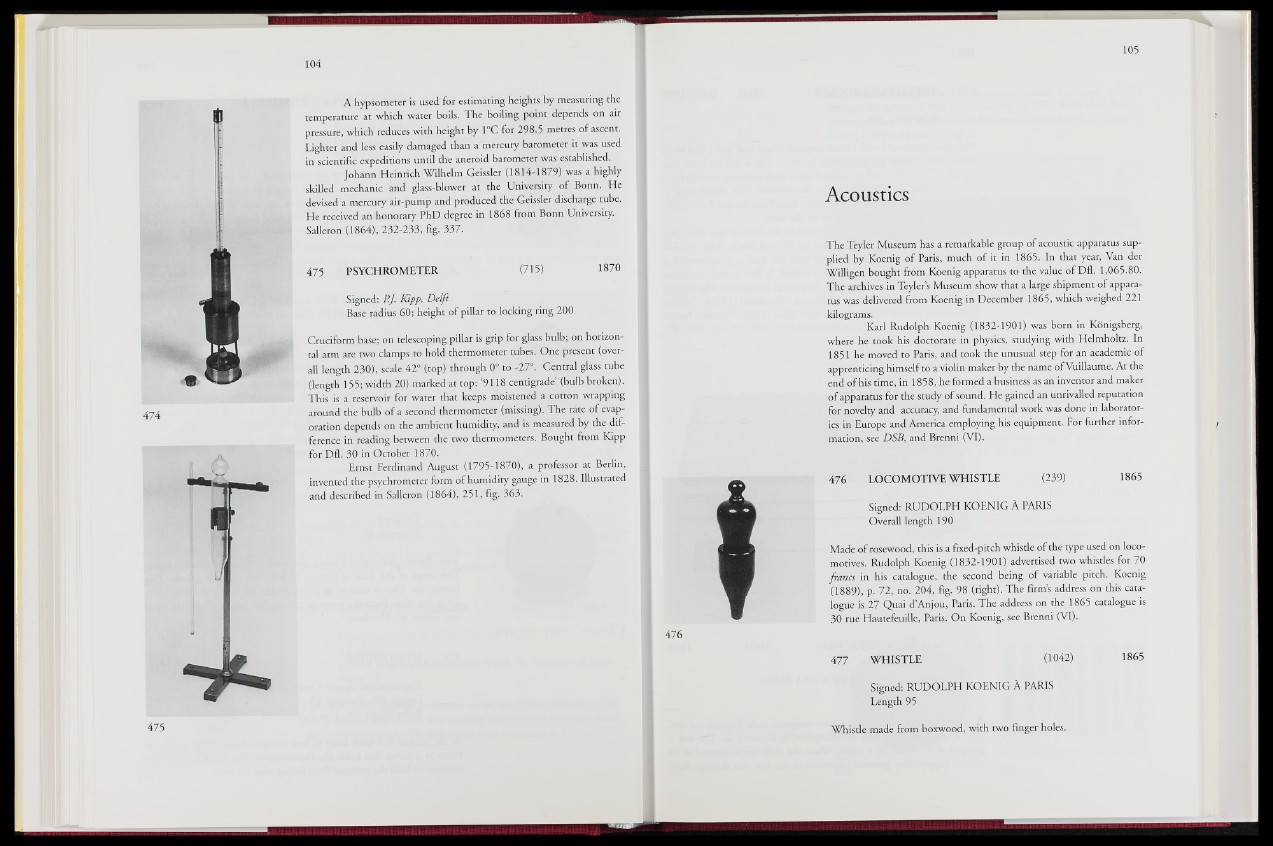
A hypsometer is used for estimating heights by measuring the
temperature at which water boils. The boiling point depends on air
pressure, which reduces with height by 1°C for 293.5 metres of ascent.
Lighter and less easily damaged than a mercury barometer it was used
in scientific expeditions until the aneroid barometer was established.
Johann Heinrich Wilhelm Geissler (1814-1879) was a highly
skilled mechanic and glass-blower at the University of Bonn. He
devised a mercury air-pump and produced the Geissler discharge tube.
He received an honorary PhD degree in 1868 from Bonn University.
Saileron (1864), 232-233, fig. 337.
475 PSYCHROMETER (715) 1870
Signed: P.J. Kipp, Delft
Base radius 60; height of pillar to locking ring 200
Cruciform base; on telescoping pillar is grip for glass bulb; on horizontal
arm are two clamps to hold thermometer tubes. One present (overall
length 230), scale 42° (top) through 0° to -27°. Central glass tube
(length 155; width 20) marked at top: ‘9118 centigrade’ (bulb broken).
This is a reservoir for water that keeps moistened a cotton wrapping
around the bulb of a second thermometer (missing). The rate of evaporation
depends on the ambient humidity, and is measured by the difference
in reading between the two thermometers. Bought from Kipp
for Dfl. 30 in October 1870.
Ernst Ferdinand August (1795-1870)’, a professor at Berlin,
invented the psychrometer form of humidity gauge in 1828. Illustrated
and described in Salleron (1864), 251, fig- 363.
Acoustics
The Teyler Museum has a remarkable group of acoustic apparatus supplied
by Koenig of Paris, much of it in 1865. In that year, Van der
Willigen bought from Koenig apparatus to the value of Dfl. 1,065.80.
The archives in Teyler s Museum show that a large shipment of apparatus
was delivered from Koenig in December 1865, which weighed 221
kilograms.
Karl Rudolph Koenig (1832-1901) was born in Königsberg,
where he took his doctorate in physics, studying with Helmholtz. In
1851 he moved to Paris, and took the unusual step for an academic of
apprenticing himself to a violin maker by the name of Vuillaume. At the
end of his time, in 1858, he formed a business as an inventor and maker
of apparatus for the study of sound. He gained an unrivalled reputation
for novelty and accuracy, and fundamental work was done in laboratories
in Europe and America employing his equipment. For further information,
see DSB, and Brenni (VI).
476
476 LOCOMOTIVE WHISTLE (239) 1865
Signed: RUDOLPH KOENIG A PARIS
Overall length 190
Made of rosewood, this is a fixed-pitch whistle of the type used on locomotives.
Rudolph Koenig (1832-1901) advertised two whistles for 70
francs in his catalogue, the second being of variable pitch. Koenig
(1889), p. 72, no. 204, fig. 98 (right). The firm’s address on this catalogue
is 27 Quai d’Anjou, Paris. The address on the 1865 catalogue is
30 rue Hautefeuille, Paris. On Koenig, see Brenni (VI).
477 WHISTLE (1042) 1865
Signed: RUDOLPH KOENIG A PARIS
Length 95
Whistle made from boxwood, with two finger holes.